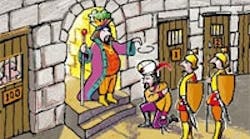Open-door policy
Problem 163 — Political promises are good only upon delivery, as this month’s problem by P. Venkataranam of Bangalore, India, demonstrates.
It was Chief Adi Omen’s 50th birthday. Minister Takitall greeted the Chief with politeness and inquired, “Shall we release all 100 prisoners from the royal jail cells today?
“No,” bellowed the chief. “Not all the prisoners. You will go around the cells 100 times. For the first round you will open all the doors. For the second round, you will close every second door, starting with Cell 2. For the third round you will visit every third cell, starting with Cell 3, i.e. Cell 3, Cell 6, Cell 9... If the door is open, close it. If the door is closed, open it. For the fourth round, every fourth cell starting with Cell 4. Again, if the door is open, close it; if it is closed, open it. Fifth round, every fifth cell starting with Cell 5...
“Continue this pattern for 100 rounds. After this all the prisoners whose doors are open may leave.”
How many prisoners were able to leave?
Technical consultant: Jack Couillard, Menasha, Wis.
Solution to last month’s problem 162 — You know your way around a tight situation if you answered no. Here’s how Gotrocks ended up in the hot seat:
We must first find the radius of the circumscribing circle. Assume maximum tolerance for the three wires.,Thus their diameters are 0.255 in. and their radii are 0.1275 in.
First, draw three straight lines connecting the center points of the three wires (see diagram). Since these circles are the same size, their center points are equidistant from each other. Their center points are also equidistant from the center point of the circumscribing circle. Thus, these lines form an equilateral triangle.
Next, draw straight lines connecting the center points of the small circles to the center point of the circumscribing circle. These lines trisect both the triangle and the circumscribing circle. Hence, the angles between these lines are each 120 deg.
Since the large triangle is an equilateral triangle, each of its angles is 60 deg. The lines leading to the centerpoint of the circumscribing circle bisect these angles. Hence, the smaller angles of the three triangles are each 30 deg.
To find the radius of the circumscribing circle, we must find the distance from the center point of any of the wires to the center point of the circumscribing circle.
Call this distance x.
The radius of the circumscribing circle is 0.1472 in. + 0.1275 in. 50.2747 in.
With both the 0.010-in. pipe tolerance and the 0.020-in. radial difference between the circumscribing circle and pipe ID, the minimum acceptable ID is 0.599 60.010 in.
Gotrocks will certainly be lighting up the night!
Contest winner — Congratulations to Ronald C. Scheffler Sr., of Angola, N.Y., who won our May contest by having his name drawn from the 58 contestants who answered correctly out of a total of 126 for that month. A TI-68 calculator is in the mail to him.
The TI-68 Advanced Scientific Calculator by Texas Instruments can solve five simultaneous equations with real and complex coefficients and has 40 number functions that can be used in both the rectangular and polar coordinate systems. Other functions include formula programming, integration, and polynomial root finding. The calculator also features a last-equation replay function that lets you doublecheck your work.
You can also receive a TI-68 and credit in the magazine if you send in an original problem with solution, and we publish it.


